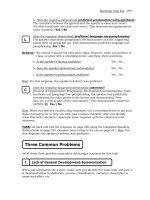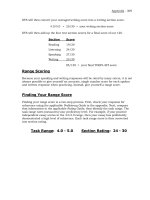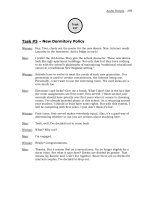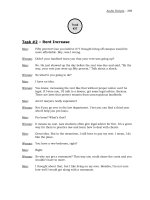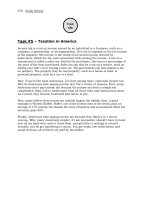Tài liệu Speaking and Writing Strategies for the TOEFL iBT part 15 doc
Bạn đang xem bản rút gọn của tài liệu. Xem và tải ngay bản đầy đủ của tài liệu tại đây (271.42 KB, 10 trang )
Integrated Essay - 129
When the reading time is up, the reading passage will leave the screen. It will be
replaced by the lecture. As you listen:
1. Look at the Lecture side of your note map.
2. Anticipate the counter argument using the black-and-white rule.
3. Listen for signal words that identify the opinion, the body
paragraphs and the conclusion. Note the cause-and-effect
relationship in each.
TASK: Take notes as you listen to a lecture on teleconferencing.
Lecture
G however
Ti however
C
Ti however
C
Ti however
C
C however
Listen to the lecture; summarize it.
Step #2
CD
Track
#3
130 - Integrated Essay
y
When the lecture ends, it will leave your computer screen. The reading passage will
return. You will also see the prompt.
TASK: Using the reading notes already illustrated and your lecture notes,
write a first draft using either point-by-point or block style. Type
your essay. Don’t time yourself. Just write. Replay the lecture as
needed for practice.
Check your first draft for coherence using the Integrated Essay
Proficiency Checklist on page 314.
TASK: Rate your teleconferencing essay using the Integrated Essay Rating
Guide on page 316.
Prompt Summarize the points made in the lecture and show
how they cast doubt on the points made in the
reading.
Read the prompt; write a first draft.
Step #3
Check your first draft for Coherence using OPDUL=C.
Step #4
Revise your first draft using your revision checklist.
Step #5
Submit your essay.
Step #6
Integrated Essay - 131
Check the following integrated essay for proficiency using OPDUL=C. What
problems can you identify?
According to OPDUL=C, this essay demonstrates:
A lack of language use-paraphrasing (OPDUL=C), specifically word
choice.
A lack of unity-synthesis (OPDUL=C), specifically topical unity.
A lack of development-summarization (OPDUL=C) of the
introductions, the bodies and the conclusions.
Combined, these three problem areas result in a lack of coherence (OPDUL=C).
Let’s analyze each so you can avoid these mistakes on test day.
He argues that zoos are a bad investment.
In addition, she claims that zoos have value.
First, he says that zoos are a waste of money. They use money
that could help poor neighborhoods.
Moreover, she argues against this.
Next, he claims that zoos are not good for animals. He uses
many clear examples, such as small cages.
Also, she argues that he is totally wrong about that.
Finally, he contends that zoos take up valuable land.
In addition, she gets really angry about that.
In sum, he argues that zoos are a waste of money.
In conclusion, she disagrees.
Three Common Problems
1
2
3
132 - Integrated Essay
y
Look at the sample essay once again. Note he and she. Because he and she are not
identified, we do not know who represents the reading and who represents the
lecture. This results in a lack of language-use paraphrasing, specifically word
choice (OPDUL
=C), and a lack of topical unity-synthesis (OPDUL=C).
Next, look at how he and she have been replaced by the reading and
the lecturer
.
He argues that zoos are a bad investment.
In addition, she claims that zoos have value.
First, he says that zoos are a waste of money. They use
money that could help poor neighborhoods.
Moreover, she argues against this.
Next, he claims that zoos are not good for animals. He uses
many clear examples, such as small cages.
Also, she argues that he is totally wrong about that.
Finally, he contends that zoos take up valuable land.
In addition, she gets really angry about that.
In sum, he argues that zoos are a waste money.
In conclusion, she disagrees.
The reading argues that zoos are a bad investment.
In addition, the lecturer claims that zoos have value.
First, the reading says that zoos are a waste of money. They
use money that could help poor neighborhoods.
Moreover, the lecturer argues against this.
Next, the reading claims that zoos are not good for animals.
The reading
uses many clear examples, such as small cages.
Also, the professor in the lecture argues that the reading is
totally wrong about that.
Finally, the reading contends that zoos take up valuable land.
In addition, the lecturer gets really angry about that.
In sum, the reading argues that zoos are a waste money.
In conclusion, the lecturer disagrees.
Lack of Language Use-Paraphrasing
1
Integrated Essay - 133
Note the transitions in the sample essay below. They are transitions of addition
(adding information). They should be transitions of contrast. This demonstrates a
lack of proficient language use-paraphrasing, specifically word choice (OPDUL
=C),
and a lack of unity-synthesis, both grammatical and topical (OPDU
L=C).
Next, look at how the writer is now using transitions of contrast.
This demonstrate unity-synthesis and language use-paraphrasing
and (OPDUL=C).
The reading argues that zoos are a bad investment.
In addition, the lecturer claims that zoos have value.
First, the reading says that zoos are a waste of money. They
use money that could help poor neighborhoods.
Moreover, the lecturer argues against this.
Next, the reading claims that zoos are not good for animals.
The reading uses many clear examples, such as small cages.
Also, the professor in the lecture argues that the reading is
totally wrong about that.
Finally, the reading contends that zoos take up valuable land.
In addition, the lecturer gets really angry about that.
In sum, the reading argues that zoos are a waste of money.
In conclusion, the lecturer disagrees.
The reading argues that zoos are a bad investment.
However, the lecturer claims that zoos have value.
First, the reading says that zoos are a waste of money. They
use money that could help poor neighborhoods.
Conversely, the lecture argues against this.
Next, the reading claims that zoos are not good for animals.
The reading uses many clear examples, such as small cages.
On the contrary, the professor in the lecture argues that the
reading is totally wrong about that.
Finally, the reading contends that zoos take up valuable land.
In contrast, the lecturer gets really angry about that.
In sum, the reading argues that zoos are a waste of money.
Countering that, the lecturer disagrees.
Lack of Unity-Synthesis
2
